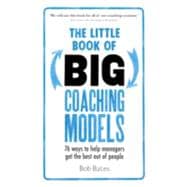Leaders and Managers want quick answers, quick ways to reach solutions, ways and means to access knowledge that won’t eat into their precious time and quick ideas that deliver a big result. The Little Book of Big Coaching Models cuts through all the noise and gives managers access to the very best coaching models that they need to get the best from their team Every model is quick and easy to read and delivers the essential information and know-how quickly, efficiently and memorably.








